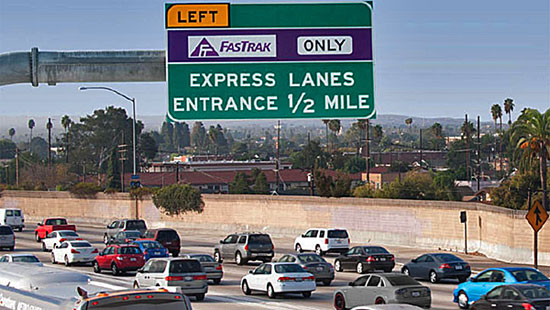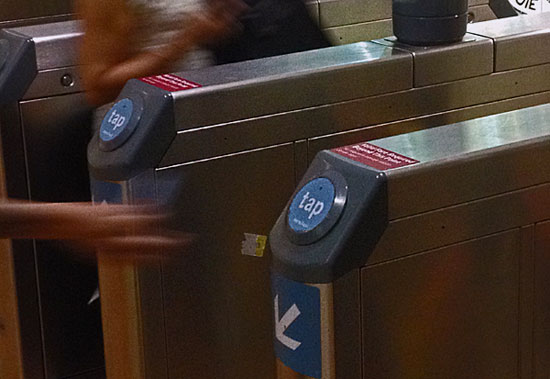Toll roads on a roll, minus fee
October 24, 2013
With drivers flocking to the ExpressLanes pilot project and revenue from the toll roads exceeding projections, Metro’s Board of Directors voted to continue to waive a controversial maintenance fee for L.A. County drivers who use the lanes only occasionally.
The board’s unanimous vote means that the $3 monthly maintenance fee will continue to be dropped for infrequent users at least until the pilot program wraps up early next year. The waiver had been set to expire on Friday, Oct. 25.
The toll roads pilot project, funded by a $210 million grant from the United States Department of Transportation, is set to conclude on Feb. 23, 2014, but if successful could be made permanent.
At the Metro board meeting Thursday, a motion to permanently drop the maintenance fee levied on occasional users was sent back to committee. Supervisor Zev Yaroslavsky, a board member who supports dropping the occasional user fee as a matter of fairness, argued in favor of moving proactively to make the waiver permanent. Given the overall boost in toll road revenue and the increase in drivers signing up for the transponders needed to take part in the program, revenue lost by waiving the maintenance fee is minimal, he said.
“Revenues generally on the ExpressLanes are far in excess of what anybody had anticipated,” Yaroslavsky said. “What we’re finding now, I believe, is that more people are signing up for [ExpressLanes] transponders because they haven’t been required to pay this fee.”
However, Supervisor Mark Ridley-Thomas said it was too soon to tinker with the program, and Supervisor Gloria Molina said there shouldn’t be a “rush to judgment” on dropping the fee before there’s a fuller study of how that might affect revenue available to reinvest in transit improvements in communities along the ExpressLanes corridors. “I don’t think we should make it permanent,” she said.
Stephanie Wiggins, who is heading up the pilot project for Metro, said that dropping the maintenance fee would cost the agency $1.5 million a year. But, she said, that is offset by the overall spike in revenue: By the end of last month, the ExpressLanes already had generated more than $20 million in gross revenues, well ahead of the $18 million to $20 million anticipated by the project’s conclusion.
According to Metro forecasts, between $16 million and $19 million of that would be available for reinvestment for transportation improvements within the corridors, Wiggins said.
In addition to the unforeseen revenue, far more people are using the program than the 100,000 originally anticipated. As of last month, 176,243 were participating, with 85,102 of those deemed occasional users because they make three or fewer trips a month on the ExpressLanes.
The first ExpressLanes opened on an 11-mile stretch of the 110 Freeway last November. A second stretch on the 10 Freeway from Alameda Street in downtown Los Angeles to the 605 Freeway opened in February.
All ExpressLanes motorists—including carpoolers—are required to obtain a FasTrak transponder and to create an account from which tolls are deducted. Except for carpoolers, all users of the system pay to drive on the ExpressLanes, with amounts varying according to distance traveled and time of day. But, to the chagrin of many, only the occasional users were targeted with the monthly maintenance fee.
The board’s decision in April to temporarily lift the $3 fee had a beneficial effect, Wiggins said.
“Throughout the county, residents are benefiting from the five-month waiver,” she said, noting that the impact has been greatest among users in the South Bay, where the number of FasTrak accounts is highest.
Marianne Kim, representing the Automobile Club of Southern California, told Metro’s board that complaints to AAA about the program have gone down since the waiver went into effect.
Beyond the positive data on revenue and driver participation in the program, there also was some generally upbeat news on travel speeds in the two ExpressLane zones.
Average travel speeds on the northbound 110 improved year-over-year in both the ExpressLanes and the general purpose non-paying lanes next to them during morning rush hour, according to measurements made by Caltrans in May and June. During the afternoon rush hour, the southbound ExpressLanes also were moving faster than they did before the project, but the general lanes were moving more slowly—30.3 mph, compared to 34.7 mph during the same period in 2012.
On the westbound 10, morning rush hour speeds improved in both the toll and general purpose lanes. However, speeds in both kinds of eastbound lanes were down during the afternoon rush hour; traffic was said to be “significantly impacted” by a Caltrans construction project in the area.
Posted 10/24/13
Kitty cat 90210
October 24, 2013
Even a cat can dream big in this town. Take Harry. Just five months ago, he was wandering the alleys. Now he lives in a landmark 6.5-acre Beverly Hills estate.
At the Virginia Robinson Gardens, a 102-year-old historic property owned by Los Angeles County, staffers say the white stray with the black tail and ear has been an unofficial colleague since April.
“He just showed up one day and started following one of the gardeners around,” said Superintendent Timothy Lindsay on a recent morning. “He was very friendly, very domesticated—and very vocal.”
“Meoooow,” confirmed Harry, glancing up from the tiled Italianate pool, where he appeared to be alternately drinking and scouring the blue water for signs of sea life.
“He likes to think there are fish in there,” whispered Lindsay.
Harry switched his tail. Lindsay said he was recently named Chief Mouser and Rat Patrol.
The property, built by the heir to the Robinson’s Department Store fortune and bequeathed to the county after his widow’s death in 1977, is a paradise, even by non-cat standards. A national, state and local landmark, it is now operated by the county Department of Parks and Recreation and supported by the nonprofit Friends of Robinson Gardens as one of Los Angeles County’s first great estates.
The owners, Harry and Virginia Robinson, were community pillars in L.A. for decades, famed for their star-studded parties, their elaborate landscaping and the many pets on whom they lavished attention.
“I think they were more dog people,” Lindsay said, noting the canine paw prints in the concrete walks connecting the estate’s five gardens. “And they had 300 blue songbirds that she imported from New Zealand, and a toucan that spent time on the loggia, eavesdropping on all the Hollywood gossip.”
But Lindsay said the cat, who sauntered in without even a microchip of identification, had such a confident air that the gardens staff named him after the estate’s founder. After a student working on the grounds volunteered to take him to the veterinarian to make sure he was vaccinated against rabies, the staff and live-in groundskeeper took him in and started to feed him.
“He’s a great mouser, and averages two a day,” says Lindsay. “He brings them to the kitchen door and drops them. And he’s so entertaining—he flops over like a dog and wants you to rub his belly. He sleeps in the laundry room in the staff quarters adjacent to the main house. We have a little bed for him.”
Harry isn’t the only creature to have adopted the gardens, says Lindsay. Coyotes drop in occasionally, and two horned owls have taken up residence in the estate’s King Palm grove. But, he says, the cat is the estate’s only domestic pet.
“He’s made this his house,” Lindsay said as Harry trotted across the flossy emerald lawn, settling in for a nap near the Renaissance Revival pool pavilion, which was modeled after Italy’s famed Villa Pisani. “The cat’s no dummy. He picked the nicest place in the neighborhood.”
Posted 10/24/13
Bike-sharing gears up
October 24, 2013
A regional bicycle-sharing program finally appears to be getting onto the fast track in Los Angeles County.
Metro’s Board of Directors on Thursday voted to begin the process of determining how a program would be structured here, including how best to solicit bids from companies interested in running it.
The board instructed Metro staff to get to work on the nuts and bolts of the issue next month, with a report due back in January on how best to proceed.
That report should include an analysis of how the program might be rolled out in phases, based on things like “existing bicycle infrastructure, existing advertising policies, current ridership trends, and transit station locations,” according to a motion by L.A. Mayor Eric Garcetti, supervisors Zev Yaroslavsky and Don Knabe, and two other Metro directors, Mike Bonin and Pam O’Connor.
Bike-sharing has become increasingly common in European cities over the past two decades, and is enjoying a surge of popularity in some U.S. cities as well. The motion cited programs in Chicago, Denver, Minneapolis, New York and in the San Francisco region, where “Bay Area Bike Share” launched earlier this year.
But in Los Angeles—despite the board’s long-running desire to implement a bike-share program here—there have been some bumps in the road.
For example, a plan backed by former L.A. Mayor Antonio Villaraigosa, which would have created a bike-sharing network within the city of Los Angeles, foundered when it turned out that the operating company’s plan to sell advertising on its kiosks was precluded by some existing city contracts.
“The Los Angeles region has seen a variety of bicycle share efforts, but none have taken hold because of a lack of regional coordination,” the motion noted.
In light of that, the Metro board also voted to support Santa Monica, which has received a grant to create its own bike-share system, in its efforts to obtain an extension on that funding so that its project can be built in tandem with the regional whole.
As the region’s transit network grows, a bike-sharing program aims to make it easier for public transportation commuters to take the bus, train or subway to get close to their destination, then grab a rental bicycle from fleets strategically located at key stations to conquer the final leg.
Finally, in a sign of the times for a changing Los Angeles region, the motion adopted Thursday also, for the first time, makes supporting bicycling as a “formal transportation mode” an official part of Metro policy.
Eric Bruins, planning and policy director for the Los Angeles County Bicycle Commission, welcomed the board’s action. He said it was understandable that it had taken so long for development of a regional bike-share program here, given the sprawling and complex nature of Los Angeles County and the need to come up with viable business models for this area.
After years of trying, is this time the charm? Bruins raised his crossed fingers and smiled.
Posted 10/24/13
Capturing money for women’s jail
October 24, 2013

The board moved to protect more than $100 million in state grants for a "women's village" in Lancaster.
For months, problems inside Los Angeles County’s jail system for men have taken center stage at Board of Supervisors meetings. This week, it was the women’s turn.
Faced with the potential of loss of more than $100 million in state grants, the supervisors on Tuesday approved an 11th-hour plan to shift the location of a proposed “women’s village” to Mira Loma Detention Center in Lancaster to free-up space at the current jail for women in Lynwood.
Initially, new beds for female inmates were planned for the Pitchess Detention Center in the Antelope Valley. But the project stalled because of real estate easement issues, prompting restless state officials to warn the county that it could lose its conditionally-awarded grants to other jurisdictions without swift action on an alternative.
According to L.A. County officials, the alternative turned out to be better than the original.
Substantial space opened up at Mira Loma after the federal Immigration and Custom Enforcement Bureau terminated its contract there, leaving behind detention beds and infrastructure that, for less money, would allow for more beds than at Pitchess—1,604 versus 1,156. The additional beds, according to the county’s Chief Executive Office, would be used to help inmates with mental health and substance abuse issues as well as to prepare the women for “reentry” into society.
“I think that L.A. County has an opportunity with this facility to design a national model for the treatment of female offenders,” said Assistant Sheriff Terri McDonald, who oversees the department’s custody operations.
Currently, female inmates are packed into the Century Regional Detention Facility in Lynwood, where capacity is at 160 percent, according to sheriff’s officials, who say most inmates are being released after serving just a fraction of their sentences, if any at all.
The Mira Loma plan is part of a much broader undertaking by the county to rethink inmate housing for the nation’s largest county jail system, including razing the archaic Men’s Central Jail, where allegations of violence by sheriff’s deputies has led to scores of reforms. Among other things, the Board of Supervisors has begun exploring the possibility of constructing a stand-alone facility for the incarceration and treatment of mentally ill inmates at a potential cost of more than $1 billion. On Tuesday, the board voted only to shift the site of the proposed “women’s village” to Mira Loma, not to approve its actual renovation.
The only supervisor to speak against the plan was Mark Ridley-Thomas. Despite the danger of losing more than $100 million in state funds, he said he wanted to approach jail construction “in a comprehensive manner rather than a piecemeal manner.”
“All money ain’t good money in terms of where we think we should be headed,” Ridley-Thomas said of the grants.
But Supervisor Zev Yaroslavsky called the board’s action a “no brainer” in light of the widely agreed upon need for new beds for female inmates. Yaroslavsky said that, if the county failed to act on the grant money now, state officials might reject requests for money down the road.
“My first question would be: ‘Well, you had money on the table. You didn’t pick it up. Why are you coming to us now?’” Yaroslavsky said, adding: “The logical extension of doing nothing is to do nothing. And doing nothing is not in our best interest from any point of view.”
The board’s vote was 4-0, with Ridley-Thomas abstaining.
Posted 10/24/13
Metro locks in more revenue
October 17, 2013
Do the math. Taking L.A.’s subway system off the honor system should mean a bump for Metro’s bottom line—and that’s exactly what happened in the first month since gate-latching was completed.
According to Metro’s data for September—the first full month available—revenues have increased by 40% when compared to May, the last month before the lengthy gate latching process started. If that increase holds steady, it would mean an extra $6 million in collected fares each year, said David Sutton, Metro’s deputy executive officer in charge of the project.
“An increase in revenue like this can be put back into the system,” Sutton said. “We can increase our hours of operation, add train cars, we can buy more buses—there is a whole myriad of things we can do with that money.”
Meanwhile, weeding out freeloaders means that ridership on the subway lines has decreased, even as the number of paying customers using TAP cards to gain access to the Red and Purple lines has skyrocketed.
Fare evaders are now unable to freely enter the system and, for the most part, have moved on to other modes of travel, Sutton said, giving paying customers a better ride by improving their security and safety—and by opening up a little more elbow room.
Even with the gates latched, some committed scofflaws will always find ways to game the system, Sutton said. About 19,000 people entered the subway without paying in September, using a variety of tricks or blatantly jumping the gates. Metro is in the process of tweaking the new system to make fare evasion more difficult, and the Sheriff’s Department is issuing citations to catch those who squeeze through.
Nonetheless, in most places the system is working well. During one morning rush hour this week, transit patrons streamed through the gates at the North Hollywood station, tapping in succession as they rushed to catch the next train. At ticket vending machines, fare purchases were made swiftly, with no long lines forming.
A few cyclists were slow getting through, lifting their bikes over the top of turnstiles or, like one young woman, tapping a fare card before pushing through an emergency gate. Sutton said cyclists can currently use the elevator to access the system, but few avail themselves of the option. Metro is planning to add a new gate, similar to the gates for disabled patrons, that will offer cyclists an easier path.
And a few fare-beaters were still trying to get a free ride. One teenager hopped over the gate, singing loudly to the music on his headphones.
But, glitches aside, gate latching has already proved transformative for the transit agency. Metro currently is working to bring some latched gates to its expanding light rail system. While not all stations can be latched due to logistical barriers, Sutton said he believes fare collection will continue to improve as Metro latches some stations along the Gold, Blue and Green lines, an effort scheduled for completion by February, 2014.
More than a million TAP cards are currently active in the system, about twice as many as when ticket vending machines were made TAP-only two years ago.
“If you look at the numbers and you look at the behavior, people are tapping,” he said. “I don’t think we’ve ever had gates; it’s a big behavioral change.”
With the assistance of help phones near entry points, Metro has been able to accomplish that change without having staff present at every station.
“It’s been incredibly smooth—we were expecting a lot more customer pushback,” Sutton said. “The biggest thing I remember is people that would give us a thumbs-up and say ‘it’s about time.’ People that pay want and expect everyone else to pay.”
Posted 10/17/13
Bark if you love story time
October 17, 2013

Hanna, a Labrador retriever mix, interrupts a library learning session to show the student a little love.
Reading out loud can be a tall order for beginners, unless they have an accepting, non-judgmental audience.
And if that audience is wagging, licking or even drooling, so much the better.
Last Saturday, kids at the Studio City Library had a chance to try out their reading skills on an unusual cadre of canine literati—courtesy of an organization called BARK, which for more than 5 years has been bringing specially-trained dogs into libraries throughout the county and beyond.
The goal of the program is to help kids who may be nervous about their reading ability loosen up and have a little fun with the learning process.
“The dogs don’t judge or laugh at them if they make a mistake,” said Josie Gavieres, director of BARK. “It makes reading a fun experience—kids will even turn the book around to show the dogs the pictures. It’s really cute.”
To get your child involved, check BARK’s calendar for numerous other times and locations. If you want to lend a hand—or paw—to BARK’s mission, the organization is seeking human and canine volunteers to staff events and spread the word.
Gavieres started BARK, which stands for Beach Animals Reading with Kids, in 2007, out of a desire to get kids reading and her love of animals. Starting with just one dog, she drew on past experience training guide dogs for the blind and working for animal shelters. She discovered that there were similar programs throughout the country but decided to forge her own path, contacting elementary schools in the Long Beach area. After 9 schools declined, the 10th said yes.
“Then it just started growing,” Gavieres said.
Word about the pet project spread quickly. Despite its beach-oriented name, the organization now draws volunteers throughout L.A. and Orange counties—at schools, libraries, senior living facilities and veteran centers. Volunteer owners and dogs typically come from each facility’s area. BARK receives funding from animal nonprofit organizations, businesses and private donors. The demand is still growing, with 8 libraries and 20 schools currently on a waiting list.
BARK requires all of its dogs to be Canine Good Citizens, an American Kennel Club certification program that focuses on training responsible owners and well-mannered dogs. After that, each dog is evaluated to make sure it is patient and well-behaved enough to work in crowds of kids, who often swarm the dogs in excitement.
“We want that dog whose tail is wagging and he’s smiling and rolling on his back saying ‘Please, more,’ ” Gavieres said.
Dogs will be dogs, though, and the strict code of silence in libraries is sometimes more than they can handle. If distracted by an outside disturbance, the dogs occasionally bark out of instinct, Gavieres said. On the other hand, the silent atmosphere can make the animals a bit too peaceful at times. “We do have dogs that occasionally fall asleep while listening,” Gavieres chuckled. “I have instructed the volunteers to say, ‘He listens better with his eyes closed.’ ”
From librarians’ perspective, the dogs serve an important purpose—getting kids and parents to go to libraries in the first place. Once there, the real work of improving literacy can begin. Last month marked the first time BARK came to Studio City Library, said Wendy Westgate, the children’s librarian. Westgate is a big fan of the program, and she approached her branch manager with the idea of bringing in the dogs monthly for a test run. So far, it’s been successful, Westgate said, drawing 22 kids in September.
Meanwhile, Gavieres revels in the stories from satisfied parents, teachers and librarians.
“Every time I hear about a little boy or a little girl who wouldn’t read that we helped … that just opens up the world for them.”
Posted 10/10/13
A loss as big as all outdoors
October 17, 2013
Some people spend their lives trying to move mountains. Dave Brown was more ambitious: He devoted his life to ensuring that the mountains remain unchanged.
Brown, an historian, environmental activist and college professor who died Saturday at the age of 79 at his home in Calabasas, was remembered this week as a lifelong civic voice for the coastal trails, streams, hills and canyons in the wilderness area where he lived since 1966.
“His soul was devoted to the Central Santa Monica Mountains and the part of the Simi Hills that touches the Santa Monica Mountains,” said Paul Edelman, deputy director of natural resources and planning at the Santa Monica Mountains Conservancy, where Brown had served as a member of the advisory board since the mid-1980s.
“He was just this guardian and watchdog who would go to incredible lengths to make sure they were protected, and who cared about every major piece.”
Brown, who was born in Illinois and moved to California as a graduate student in the late 1950s, taught history and political science for more than 40 years at Los Angeles Valley College in Van Nuys, but was also known locally for his passionate efforts, starting in the 1970s and early 1980s, to halt development in the pristine mountains.
Working determinedly within the local environmental movement, Brown contributed to the preservation of tens of thousands of acres. He was one of a number of local influencers who helped stop the development of King Gillette Ranch, which had been slated to become part of a Soka University expansion; now the ranch hosts the Visitor’s Center of the Santa Monica Mountains National Recreation Area. His advocacy also helped save or create such important wilderness landmarks as Malibu Creek State Park, the Zev Yaroslavsky Las Virgenes Highlands Park and the Backbone Trail.
Over time, he became sought after as an informed and pragmatic voice on local land use issues, and he served on the city of Calabasas’ Planning Commission for several decades, winning national recognition for his civic contributions. He also devoted countless hours to the Sierra Club, the Audubon Society, the Malibu Creek State Park Docents and other environmental organizations. (To catch a moment of a Brown-led tour of the park several years ago, click here.)
“He was an incredible, encyclopedic resource,” said Kim Lamorie, who knew him as a 35-year member of the Las Virgenes Homeowners Federation, of which Lamorie is president.
“He knew all the properties, he knew all the trees, he knew every ridgeline. And he was a master mapper. He had more maps than anyone I’ve ever known.”
“He was a big man with a big hat and a big voice, and he spoke with a lot of authority,” said John Suwara, a friend and neighbor of nearly four decades. “Dave was a realist, but he fought tooth and nail, right up to the end.
“Even as recently as March, he was going to Planning Commission meetings and reviewing documents. That was maybe the biggest thing about him—he did it day after day, year after year, decade after decade. He wasn’t one of these people who are there one day and gone the next.”
In fact, Edelman said, because of Brown’s longevity and commitment, there are now spots in the Santa Monica Mountains in which every visible piece of the wilderness, all the way to the horizon, is arguably there, at least in part, because of him.
“There’s one overlook on Piuma Road,” he said, “where everything you see is something he had an absolute hand in, from the valley bottom to the ridge lines.”
And then there is the matter of how the mountains shaped Brown’s life and outlook.
Last year, after the majestic, 200-acre Firehouse Hill—now the Zev Yaroslavsky Las Virgenes Highlands Park—was saved from development in Calabasas, Brown, by then in frail health, stood among its oaks and considered what the place meant to him.
“I sometimes sort of tell myself that if the Lord should see fit to send me upstairs instead of downstairs,” he said, “I would expect that I would walk up to heaven through a place like this.”
Posted 10/17/13
Market’s got a brand new bag
October 15, 2013
Attention, Grand Park shoppers: plastic bags are no longer on the menu at your weekly farmer’s market.
On Tuesday, merchants started handing out paper bags with purchases, and park employees distributed more than a hundred free, reusable tote bags to shoppers who agreed to fill out a short, six-item questionnaire about their market experience.
“We ran out in the first two hours,” said Karen Tran, one of two workers handing out the totes.
The market’s manager, Susan Hutchinson, said some merchants had initially expressed concerns that paper bags would be more expensive than plastic and would not hold up as well to potentially messy items, like ripe peaches and plums.
Both fears proved to be unfounded when vendors transitioned from Styrofoam clamshell containers to cardboard, and she expects an equally smooth transition to the new bags, which are required under county law and will be mandated by the city as well beginning Jan. 1, Hutchinson said.
“The reality is it’s not such a big deal,” Hutchinson said. “People adapt.” She’s hoping that customers’ adaptation will include remembering to bring their own reusable bags to the market, which runs from 10 a.m. to 2 p.m. on Tuesdays.
On Day 1, the lunch time crowd seemed to welcome the change.
“I think it’s great,” said county employee Nyla Jefferson, carrying two paper bags loaded with apples, peaches, plums and blueberries.
LAPD Detective Ron Walker held one of the free tote bags as he waited for his apple feta salad to be prepared. He said he was glad to see the bag policy change.
“Even supermarkets are charging for bags now,” he said.
Posted 10/15/13
After a short stall, budget passes
October 9, 2013
The Los Angeles County Board of Supervisors on Tuesday gave final approval to a budget that reflects improving revenues from a rebounding economy, along with urgent new demands on those funds for jail reform, improvements in the child welfare system and other looming needs.
But getting there wasn’t easy. A short-lived—though potentially damaging—budget standoff temporarily stopped the process in its tracks and drew comparisons to the ongoing showdown in Washington D.C. before it was resolved.
It was the first time in memory that the usually routine action of recognizing supplemental revenue in the county budget had been derailed in such a manner, if even for a brief period.
The $362.4 million being transferred in this year’s supplemental budget process was intended to fund a variety of county initiatives—from implementing recommendations by the Citizens’ Commission on Jail Violence to hiring 147 additional children’s social workers to enhancing contract monitoring of foster family agencies and group homes. With property and sales tax revenues on the upswing and an infusion of funds following the state’s disbanding of redevelopment agencies, there was also money for maintenance and capital projects that had been deferred during the lean days of the Great Recession.
Tuesday’s standoff started when Supervisor Mark Ridley-Thomas balked at placing two chunks of the supplemental revenue—totaling $55 million and $20 million—into the county’s extraordinary maintenance and capital project budgets, respectively.
Instead, he argued, the funds should go into the county’s rainy day fund to cover unexpected needs that may crop up. That fund, as of Tuesday, had just over $232 million in it.
Ridley-Thomas’ motion, opposed by Supervisors Don Knabe, Gloria Molina and Zev Yaroslavsky, drew the support of Supervisor Michael D. Antonovich—and that was enough to deprive the supplemental budget item of the 4-vote super-majority needed for passage.
“It’s just like the feds. We have no budget,” Molina said incredulously.
Yaroslavsky said the 11th hour hitch in the budget process was “a Tea Party-esque kind of thing.”
The development came hours into a marathon meeting at which the eventual passage of the supplemental budget—the last step in approving the county’s official spending plan for fiscal 2013-14—had seemed assured. The stalemate was broken a short time later, when Antonovich moved reconsideration of the item.
Antonovich suggested that the two pots of money—the $55 million and $20 million—be combined in the CEO’s budget to address either capital projects or extraordinary maintenance needs in this fiscal year.
That proposal passed unanimously, and the county’s supplemental budget was approved, largely in the same form originally recommended by Chief Executive Officer William T Fujioka.
After the reversal, Yaroslavsky called the whole episode “a bizarre way to do business.”
“It was disconcerting but I suppose one could say, to quote Churchill, ‘Democracy eventually does the right thing, but only after exhausting all the alternatives.’ ”
Posted 10/9/13



















 Check for the latest closure information
Check for the latest closure information








